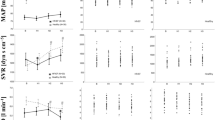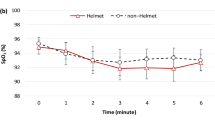Abstract
This two-part study sought to determine the relationship between arterial Pco2, CO2 chemoresponsiveness, and ventilation during exercise in healthy children and children with cystic fibrosis (CF). In the first part, we measured the hypercapnic ventilatory response (HCVR) in 16 healthy children and 16 patients with CF, and compared HCVR with the ventilatory response to progressive exercise (Δ˙Ve/Δ˙Vco2). In the second part, we assessed the relation between age, the ventilatory equivalent for CO2 (˙Ve/˙Vco2), and arterialized capillary Pco2(Paco2), during exercise in 28 healthy children and 23 children with CF. The HCVR showed an age-related decline in both healthy controls and CF subjects. In addition, there was a correlation between forced expiratory flow from 25 to 75% of forced vital capacity and the HCVR, regardless of age. In controls, but not in CF, there was also a decline inΔ˙Ve/˙Vco2 with increasing age; and there was a significant correlation between Δ˙Ve/Δ˙Vco2 and HCVR. Findings in the second part were similar, with a significant inverse correlation between age and ˙Ve/˙Vco2 during steady state exercise only in healthy controls. However, when physiologic dead space was taken into account, both CF and healthy control children showed a significant decline in ˙Va/˙Vco2 with age. When all subjects were grouped together, there was a statistically significant correlation between Paco2 and age, such that younger subjects had lower Paco2 than older subjects. Age and Paco2 together accounted for 71% of the variance in ˙Va/˙Vco2. We conclude that younger children ventilate proportionately more on exercise than older children because they regulate Paco2 about a lower set point. As the ventilatory response to exercise is significantly correlated with the HCVR, and the latter can be reduced in the presence of airways obstruction, an innately low HCVR could permit the development of exertional hypercapnia in some CF patients with advancing pulmonary disease.
Similar content being viewed by others
Log in or create a free account to read this content
Gain free access to this article, as well as selected content from this journal and more on nature.com
or
Abbreviations
- HCVR:
-
hypercapnic ventilatory response(VC·min-1·mm Hg-1)
- ˙Ve:
-
expired ventilation
- ˙Va:
-
alveolar ventilation
- ˙Ve/˙Vco2:
-
ventilatory equivalent for CO2 in steady state exercise
- Δ˙Ve/Δ˙Vco2:
-
slope of ventilation versus CO2 output in progressive exercise (these ratios are dimensionless)
- Petco2:
-
end-tidal Pco2 [mm Hg (kPa)]
- FEV1:
-
forced expiratory volume in the first second (% predicted)
- VC:
-
vital capacity
- FVC:
-
forced vital capacity (liters or% predicted)
- FEF25-75:
-
forced expiratory flow from 25 to 75% of FVC (% predicted)
References
Cooper DM, Kaplan MR, Baumgarten L, Weiler-Ravell D, Whipp BJ, Wasserman K 1987 Coupling of ventilation and CO2 production during exercise in children. Pediatr Res 21: 568–572
Jones NL 1976 Use of exercise in testing respiratory control mechanisms. Chest 70( suppl): 169–173
Martin BJ, Weil JV, Sparks KE, McCullough RE, Grover RF 1978 Exercise ventilation correlates positively with ventilatory chemoresponsiveness. J Appl Physiol 45: 557–564
Rebuck AS, Jones NL, Campbell EJM 1972 Ventilatory response to exercise and to CO2 rebreathing in normal subjects. Clin Sci 43: 861–867
Pianosi P, Khoo MCK 1995 Change in the peripheral CO2 chemoreflex from rest to exercise. Eur J Appl Physiol 70: 360–366
Gratas-Delamarche A, Mercier J, Ramonatxo M, Dassonville J, Préfaut C 1993 Ventilatory response of prepubertal boys and adults to carbon dioxide at rest and during exercise. Eur J Appl Physiol 66: 25–30
Marcus CL, Glomb WB, Basinski DJ, Davidson Ward SL, Keens TG 1994 Developmental pattern of hypercapnic and hypoxic ventilatory responses from childhood to adulthood. J Appl Physiol 76: 314–320
Godfrey S, Davies CTM, Wozniak Barnes CA 1971 Cardiorespiratory response to exercise in normal children. Clin Sci 40: 419–431
Oren A, Wasserman K, Davis JA, Whipp BJ 1981 Effect of CO2 set point on ventilatory response to exercise. J Appl Physiol 51: 185–189
Coates AL, Canny G, Zinman R, Grisdale R, Desmond KJ, Roumeliotis D, Levison H 1988 The effects of chronic airflow limitation, increased dead space, and the pattern of ventilation on gas exchange during maximal exercise in advanced cystic fibrosis. Am Rev Respir Dis 138: 1524–1531
Nixon PA, Orenstein DM, Kelsey SF, Doershuk CF 1992 The prognostic value of exercise testing in patients with cystic fibrosis. N Engl J Med 327: 1785–1788
Beaver WL, Wasserman K, Whipp BJ 1986 A new method for detecting anaerobic threshold by gas exchange. J Appl Physiol 60: 2020–2027
Read DJC 1966 A clinical method for assessing the ventilatory response to carbon dioxide. Aust Ann Med 16: 20–32
Rebuck AS 1976 Measurement of ventilatory response to CO2 by rebreathing. Chest 70( suppl): 118–121
Rebuck AS, Rigg JRA, Kangalee M, Pengelly LD 1974 Control of tidal volume during rebreathing. J Appl Physiol 37: 475–478
Knudson RJ, Lebowitz MD, Holberg CJ, Burrows B 1983 Changes in the normal maximal expiratory flow-volume curve with growth and aging. Am Rev Respir Dis 127: 725–734
Coates AL, Desmond KJ, Milic-Emili J, Beaudry PH 1981 Ventilation, respiratory center output, and contribution of the rib cage and abdominal components to ventilation during CO2 rebreathing in children with cystic fibrosis. Am Rev Respir Dis 124: 526–530
Lwin N, Giammona ST 1972 Ventilatory responses to inspired CO2 in patients with cystic fibrosis. Chest 61: 206–212
Fowle ASE, Campbell EJM 1964 The immediate carbon dioxide storage capacity of man. Clin Sci 27: 41–49
Aarmon Y, Cooper DM, Springer C, Barstow TJ, Rahimizadeh H, Landaw E, Epstein S 1990 Oral [13C] bicarbonate measurement of CO2 stores and dynamics in children and adults. J Appl Physiol 69: 1754–17610
Wang X, Dockery DW, Wypij D, Fay ME, Ferris BG 1993 Pulmonary function between 6 and 18 years of age. Pediatr Pulmonol 15: 75–88
Pianosi P, Lands L, Canny G, Coates AL 1988 The role of hyperinflation in limiting ventilation during exercise in advanced cystic fibrosis. Am Rev Respir Dis 137: 304A( abstr)
Dempsey JA, Mitchell GS, Smith CA 1984 Exercise and chemoreception. Am Rev Respir Dis 129( suppl): S31–S34
Acknowledgements
The authors thank Dr. V. Chernick for his thoughtful commentary on the manuscript.
Author information
Authors and Affiliations
Additional information
Funded by grants from the Children's Hospital of Winnipeg Research Foundation Inc., and the Canadian Cystic Fibrosis Foundation. R.W. was a recipient of a Manitoba Lung Association Research Fellowship.
Rights and permissions
About this article
Cite this article
Pianosi, P., Wolstein, R. Carbon Dioxide Chemosensitivity and Exercise Ventilation in Healthy Children and in Children with Cystic Fibrosis. Pediatr Res 40, 508–513 (1996). https://doi.org/10.1203/00006450-199609000-00023
Received:
Accepted:
Issue date:
DOI: https://doi.org/10.1203/00006450-199609000-00023
This article is cited by
-
The value of high-resolution computed tomography (HRCT) to determine exercise ventilatory inefficiency and dynamic hyperinflation in adult patients with cystic fibrosis
Respiratory Research (2019)
-
Exercise testing in patients with cystic fibrosis—importance of ventilatory parameters
European Journal of Applied Physiology (2019)
-
High-intensity intermittent running training improves pulmonary function and alters exercise breathing pattern in children
European Journal of Applied Physiology (2005)



